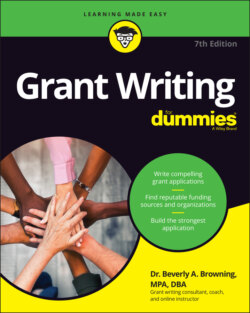Читать книгу Grant Writing For Dummies - Stan Hutton, Beverly A. Browning - Страница 39
Looking at the funding plan components
ОглавлениеThe grantfunding plan (created in table format) that I use the most for grantseeking captures eight fields in this order (see Figure 2-1):
Program, Service, or Activity: This is where you list the program, service, or activity priorities that are written in your organization’s strategic plan.
Funding Source: In this column, you identify the funding source(s) that you plan to approach to support your programs, services, or activities in the current and next fiscal years. You can have multiple funding sources that you contact for one program. Putting all your eggs in one basket (applying to only one funder) and then receiving a rejection letter nine months later is not your goal. If you did that, you would have to start all over with only three months left in the year. Approach multiple funders for every program, service, or activity in need of funding.
Address, Telephone, Email, and Website: By incorporating this column into your funding plan, you have clickable links to quickly email or review the websites of current and potential funders. Adding the mailing address reduces your time-on-task when sending out a letter of inquiry (I provide an example of this type of document later in this chapter). And, most important, the phone number is handy when you need to speak with the designated contact person for the funder.
Contact Person/Title: Research the funder’s website and even call their office to make sure that you have the correct name of the contact person and their title. Make sure to ask how the contact person gender-identifies, if there’s any chance of confusion. Names like Chris and Pat can belong to men and women.
Request: The amount of grant funding that you plan to request goes in this column. Make sure to review the funder’s profile for their grantmaking range. Stay below the top of the range if you’re a first-time grant applicant with the funder.
Application Deadline/Giving Cycle: This column captures the grant application’s deadline(s) and when grants are awarded by the funder. Some funders only accept and award grants once a year, while others may have multiple grant application submission deadlines and giving cycles.
Assigned To: In this column, you add the name(s) of the board member(s) or administrative-level staff that are assigned to making contact with the funder to continue previous funding conversations or begin initial conversations with new funders. In Chapter 22, I explain more about this process.
Status/Results: This is where you insert the status of the funding request — for example: “Contacting in September,” “First contact meeting went well on September 5, 2022,” “Grant application submitted on September 5, 2022,” or “Funding declined for September 2022 giving cycle; letter indicated to apply again next year (2023); follow-up meeting requested to discuss problems with grant application.”
© John Wiley & Sons, Inc.
FIGURE 2-1: An example of a funding plan.
